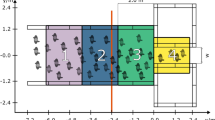Abstract
Research on pedestrian movement strives to mitigate risks at large events or public infrastructures by better understanding the flow of a crowd. Thus, for evacuation planning it is essential to understand what constitutes a crowd. This includes the crowd’s composition of various groups of people and its influence on the evacuation process. This paper is a joint effort by social scientists and mathematical modelers cooperating in the research project REPKA to shed more light on this aspect. REPKA (Regional Evacuation: Planning, (K)Control, and Adaptation) focuses on open space evacuation of big events, especially the regional evacuation of national soccer matches. Here, larger groups of fans with a spirit of togetherness are eminently present. Social scientists and mathematical modelers work on this task from different perspectives relying on the tools of their trade: Empirical surveys – interviews and observations – have been conducted by social scientists to gather information on the occurrence and relevance of large groups. They are the basic input for mathematical modelers together with first suggestions on consistent distributions for the group composition. The mathematical modelers integrate these results into a pedestrian stream model that includes larger groups composed of subgroups. They demonstrate how the occurrence of larger crowds affects the flow of a crowd at a road crossing.
Access this chapter
Tax calculation will be finalised at checkout
Purchases are for personal use only
Similar content being viewed by others
References
Coleman, J. S.; James, J. (1961): The Equilibrium Size Distribution of Freely-Forming Groups. In: Sociometry, Vol. 24, Issue 1, pp. 36–45.
Drury, J.; Stott. C. (2011): Contextualising the crowd in contemporary science. In: Journal of Contemporary Social Science 6 (3), pp. 275–288.
Hartmann, D. (2010): Adaptive Pedestrian Dynamics Based on Geodesics. In: New Journal of Physics 12 (4), pp. 1367–2630.
Helbing, D.; Farkas, I. J.; Vicsek, T. (2000): Simulating dynamical features of escape panic. In: Nature, Vol. 407, pp. 487–490.
Helbing, Dirk (2001): Traffic and related self-driven many-particle systems. In: Reviews of Modern Physics, Vol. 73 (4), pp. 1067–1141.
Helbing, D; Molnár, P.; Farkas, I.; Bolay, K. (2001): Self-organizing pedestrian movement. In: Environment and Planning B 28, pp. 361–383.
James, J. (1953): The Distribution of Freely-Forming Small Group Size. In: American Sociological Review, Vol. 18, pp. 569–570.
Köster, G.; Hartmann, D.; Klein, W. (2011a): Microscopic Pedestrian Simulations: From Passenger Exchange Times to Regional Evacuation. In: Hu, B.; Morasch, K.; Pickl, S.; Siegle, M. (eds): Operations Research Proceedings 2010: Selected Papers of the Annual International Conference of the German Operations Research Society, pp. 571–576.
Köster, G.; Seitz, M.; Treml, F.; Hartmann, D.; Klein, W. (2011b): On modeling the influence of group formations in a crowd. In: Journal of Contemporary Social Science 6 (3), pp. 397–414.
Köster, G.; Treml, F.; Seitz, M.; Klein, W. (2012): Validation of crowd models including social groups, PED 2012.
Mawson, A. R. (2005): Understanding Mass Panic and Other Collective Responses to Threat and Disaster. In: Psychiatry: Interpersonal and biological processes, Vol. 68, Issue 2, pp. 95–113.
Moussaïd, M.; Perozo, N.; Garnier, S.; Helbing, D.; Theraulaz, G. (2010): The Walking Behaviour of Pedestrian Social Groups and Its Impact on Crowd Dynamics. In: PLoS ONE, Vol. 5, Issue 4.
Qiu, F., Hu, X. (2009): Modeling group structures in pedestrian crowd simulation. In: Simulation Modelling Practice and Theory, 18, pp. 190–205.
Reichert, S. (2011): Mass action and mundane reality: an argument for putting crowd analysis at the centre of the social sciences. In: Journal of Contemporary Social Science 6 (3), pp. 433–449.
REPKA-project website: repka-evakuierung.de: [http://www.repka-evakuierung.de]
Seitz, M., Köster, G., Pfaffinger, A. (2012): Pedestrian group behavior in a cellular automaton, PED 2012.
Sime, J. D. (1983): Affiliative Behaviour during escape to building exits. In: Journal of Environmental Psychology, Vol. 3, Issue 1, pp. 21–41.
Singh, H., Arter, R., Dodd, L., Langston, P., Lester, E., Drury, J. (2009): Modelling Subgroup Behaviour in Crowd Dynamics DEM Simulation. In: Applied Mathematical Modelling 33, pp. 4408–4423.
Yang, L. Z., Zhao, D. L., Li, J., Fang, T. Y. (2005): Simulation of the kin behavior in building occupant evacuation based on Cellular Automaton. In: Building and Environment, 40 (3), pp. 411–415.
Acknowledgements
This work was partially funded by the German Federal Ministry of Education and Research through the priority program “Schutz und Rettung von Menschen” within the project REPKA—Regional Evacuation: Planning, (K)Control and Adaptation.
Author information
Authors and Affiliations
Corresponding author
Editor information
Editors and Affiliations
Rights and permissions
Copyright information
© 2014 Springer International Publishing Switzerland
About this paper
Cite this paper
Reuter, V., Bergner, B.S., Köster, G., Seitz, M., Treml, F., Hartmann, D. (2014). On Modeling Groups in Crowds: Empirical Evidence and Simulation Results Including Large Groups. In: Weidmann, U., Kirsch, U., Schreckenberg, M. (eds) Pedestrian and Evacuation Dynamics 2012. Springer, Cham. https://doi.org/10.1007/978-3-319-02447-9_70
Download citation
DOI: https://doi.org/10.1007/978-3-319-02447-9_70
Published:
Publisher Name: Springer, Cham
Print ISBN: 978-3-319-02446-2
Online ISBN: 978-3-319-02447-9
eBook Packages: Mathematics and StatisticsMathematics and Statistics (R0)




